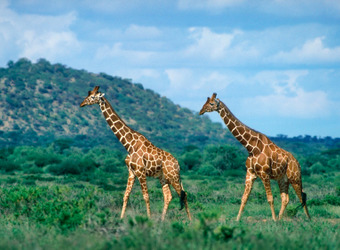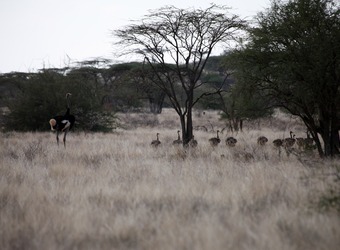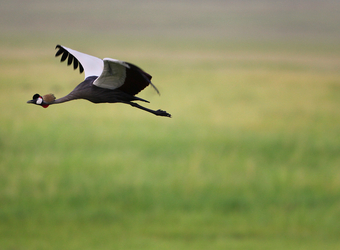Shaba Nat'l Reserve
Click here to be the first to review Shaba Nat'l Reserve
Start Planning Your Custom Safari view larger image
view larger image
In the eastern corner of the Samburu ecosystem is Shaba National Reserve, the secluded wilderness where famed conservationist Joy Adamson released her first hand-raised leopard into the wild. At home in this rugged, hilly landscape watered by the Ewaso Ngiro River is a magnificent collection of wildlife, including Grevy’s zebra, reticulated giraffe, elephant, buffalo, lesser kudu, oryx, Grant’s gazelle, Somali ostrich and abundant lion.
 view image gallery
view image gallery
The Safari Experience
With only one camp doing wildlife viewing within the Shaba National Reserve, the exclusivity of this semi-desert region is unparalleled. The reserve adjoins to Samburu National Reserve and Buffalo Springs, creating a large, protected area rich in wildlife. The dramatic scenery builds from river-side forests and dry grasslands to the presiding Shaba Hill volcano to the south. The Ewaso Ngiro River runs along a 21-mile stretch along the northern border of the reserve, dotted with unique doum palms, which are not found in the other popular parks of Kenya, but more often on the Nile River. Morning and afternoon drives by open, 4x4 vehicles reveal unique species and Africa’s coveted predators. Guided bush walks can be enjoyed in the reserve with virtually no one around. Delight in a breakfast along the riverine banks of the Ewaso Ngiro River. There are many springs on the property, which provide drinking water for the many animals residing in Shaba.
 view image gallery
view image gallery
Wildlife
The wildlife of Shaba notably includes the endangered Grevy’s zebra, which does not roam the popular areas of southern Kenya. It’s easily identified by its thinner stripes, white belly, round ears and light-colored nose. Other unique species to this region within the Somali-Maasai biome include reticulated giraffe, gerenuk, Somali ostrich and Beisa oryx. Large prides of lion are resident to Shaba, and there are also leopard and cheetah. Black-backed and golden jackals come out at night to seek small prey. Large antelopes like eland and greater and lesser kudu drink from Shaba’s springs, and you may find elephant drinking in the marshes. The William’s lark is a special bird restricted to only two areas of northern Kenya. The males stage long, obvious song flights after rains above their territory, making them easy to observe. You might spot globally threatened lesser kestrel migration through the area, or see occasional visitors like the African darter or great egret.
 view image gallery
view image gallery
How to Include Shaba in Your Safari Itinerary
Recommended Number of Nights
Nature Travelers: 2 nights combined with Lewa
Photographers: 3 nights
Families: 2 nights combined with Lewa
Active Travelers: 2 nights combined with Lewa
Other Regions to Include
While Shaba shares the same ecosystem with Samburu, it’s preferable to combine Shaba with a more varied area like Lewa Wildlife Conservancy. Lewa has a slightly varied terrain with more rolling hills, and being a rhino sanctuary, the likelihood of seeing black and white rhino here is a great complement to Shaba’s semi-arid landscape, springs and riverine forests housing plenty of unique plains game and predators. The Maasai Mara offers a wholly different experience with classic African savanna, fabled, large herds of plains game, fierce predators and the enchanting Maasai people. To the southeast of Nairobi, Amboseli National Park features huge herds of elephant that migrate daily to the marshes to drink the cool waters running down from Mount Kilimanjaro. Extend your safari into the Serengeti to observe the migration of over a million wildebeest between December and March, and stop at the iconic Ngorongoro Crater to view the menagerie of wildlife traipsing around the crater floor.
